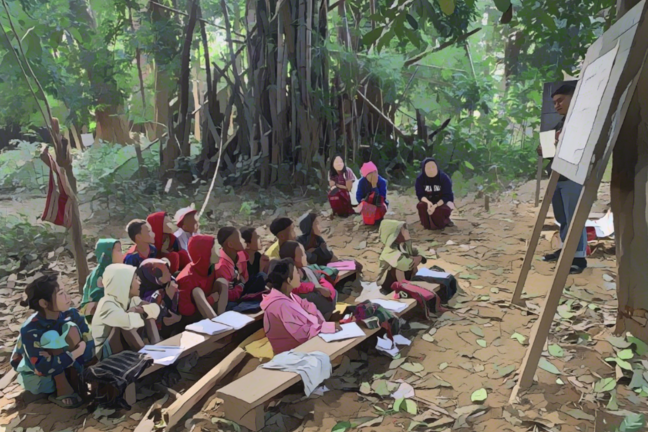1.3 Education in contexts of conflict and displacement
Displaced Karen children learning on the forest floor
Education is vital for children’s cognitive development and socio-emotional learning. It can also help children cope with trauma and cultivate a sense of purpose in their lives. Schools can offer safe spaces in which children can be protected from physical dangers such as abuse, exploitation and, in some situations, manipulation to join armed groups. In conflict-affected settings, schools can also serve as sites of humanitarian assistance where children can access food, water, medical care and hygiene supplies.
However, while schools should be safe spaces for learning and the socio-emotional development of children, in conflict-affected settings they often become targets of attacks. In such situations, violence against schools, students, and educators causes significant harm to individuals and societies. Such attacks disrupt access to learning, and promote intolerance, grief and anger. The use of educational facilities for military purposes perpetuates conflict, and undermines academic freedom and the right to education for children. This is the complex context in which we need to situate our discussions about learning and teaching.
In Week 1 of this CoMOOC, we consider aspects of the learning environment that promote safety and security within schools, and that allow children and young people to continue learning in contexts of conflict and displacement. In Weeks 2 and 3, we discuss some of the broader socio-political factors shaping education and learning in contexts of conflict and displacement, and consider the implications for teachers’ practices and education policies.
In a world scarred by conflict and displacement in so many places, the Safe Schools declaration is a world-wide commitment to an education policy that is explicit about the safety and security of students and teachers.
Safe Schools
- Every boy and girl has the right to an education without fear of violence or attack.
- Every teacher, professor, and school administrator should be able to teach and research in conditions of safety, security, and dignity.
- Every school should be a protected space for students to learn and fulfil their potential, even during war.
- Every university should be a safe place for students and academics and to foster critical and independent thinking, and to harness knowledge.
The Safe Schools Declaration is an inter-governmental political commitment, endorsed by 120 States. The aim is to protect students, teachers, schools, and universities from the worst effects of armed conflict. The initiative was developed in 2015, led by the governments of Norway and Argentina in the United Nations (UN). The declaration outlines a set of commitments to strengthen the safety of schools and prevent the use of educational institutions for military purposes. It states that:
Teachers play a crucial role in helping to make schools safe for learners and communities, often in very challenging and complex circumstances, and teachers are often the main advocates for protecting learning spaces. The implementation section of the site provides examples of teachers using digital methods to teach students when they are displaced by conflict. We look at such methods at the end of this week.
Over to you
In the forum, think and discuss about a context of conflict and/ or displacement that you know well, from your perspective:
- What role can and do teachers play in creating safe spaces through education in these contexts?
- What guidelines (if any) do schools in your communities have for the protection of learners, teachers and school infrastructures?
- What do you think is the best way to advocate for safe schools in such contexts?
- What more could be done to ensure the safety of schools and their communities?

